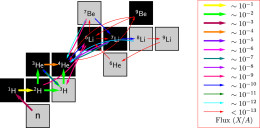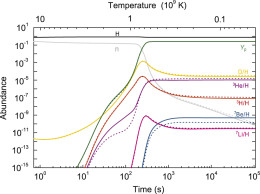How did our universe come into being? The Big Bang theory is a widely accepted and highly successful cosmological model of the universe, but it does introduce one puzzle: the “cosmological lithium problem.” Have scientists now found a solution?
Too Much Lithium
In the Big Bang theory, the universe expanded rapidly from a very high-density and high-temperature state dominated by radiation. This theory has been validated again and again: the discovery of the cosmic microwave background radiation and observations of the large-scale structure of the universe both beautifully support the Big Bang theory, for instance. But one pesky trouble-spot remains: the abundance of lithium.

The arrows show the primary reactions involved in Big Bang nucleosynthesis, and their flux ratios, as predicted by the authors’ model, are given on the right. Synthesizing primordial elements is complicated! [Hou et al. 2017]
But while predictions match the observed primordial deuterium and helium abundances, Big Bang nucleosynthesis theory overpredicts the abundance of primordial lithium by about a factor of three. This inconsistency is known as the “cosmological lithium problem” — and attempts to resolve it using conventional astrophysics and nuclear physics over the past few decades have not been successful.
In a recent publication led by Suqing Hou (Institute of Modern Physics, Chinese Academy of Sciences) and advisor Jianjun He (Institute of Modern Physics & National Astronomical Observatories, Chinese Academy of Sciences), however, a team of scientists has proposed an elegant solution to this problem.

Time and temperature evolution of the abundances of primordial light elements during the beginning of the universe. The authors’ model (dotted lines) successfully predicts a lower abundance of the beryllium isotope — which eventually decays into lithium — relative to the classical Maxwell-Boltzmann distribution (solid lines), without changing the predicted abundances of deuterium or helium. [Hou et al. 2017]
Questioning Statistics
Hou and collaborators questioned a key assumption in Big Bang nucleosynthesis theory: that the nuclei involved in the process are all in thermodynamic equilibrium, and their velocities — which determine the thermonuclear reaction rates — are described by the classical Maxwell-Boltzmann distribution.
But do nuclei still obey this classical distribution in the extremely complex, fast-expanding Big Bang hot plasma? Hou and collaborators propose that the lithium nuclei don’t, and that they must instead be described by a slightly modified version of the classical distribution, accounted for using what’s known as “non-extensive statistics”.
The authors show that using the modified velocity distributions described by these statistics, they can successfully predict the observed primordial abundances of deuterium, helium, and lithium simultaneously. If this solution to the cosmological lithium problem is correct, the Big Bang theory is now one step closer to fully describing the formation of our universe.
Citation
S. Q. Hou et al 2017 ApJ 834 165. doi:10.3847/1538-4357/834/2/165


8 Comments
Pingback: Big Bang Lithium problem solved!
Pingback: Weekly Space Hangout - February 17, 2017: Samuel Mason, Director of the Tesla Science Foundation - Universe Today
Pingback: Weekly Space Hangout – February 17, 2017: Samuel Mason, Director of the Tesla Science Foundation
Pingback: Solucionando el problema del litio en la teoría del Big Bang – Observatori Astronòmic
Pingback: El problema del litio « SEDA / LIADA - RedLIADA - Cursos LIADA - Cielo del Mes - Fenómenos Astronómicos - RELEA
Pingback: Marzo 2017 – Observatori Astronòmic
Pingback: Enceladus's Super-Thin Ice - Skeptic.live
Pingback: Enceladus’s Super-Thin Ice | Alien Cosmos